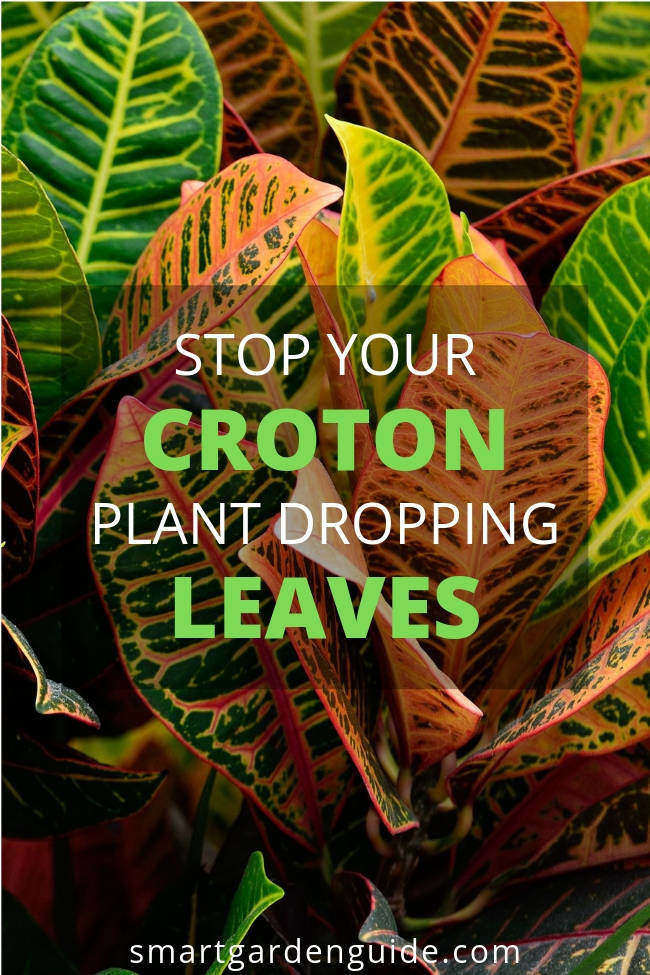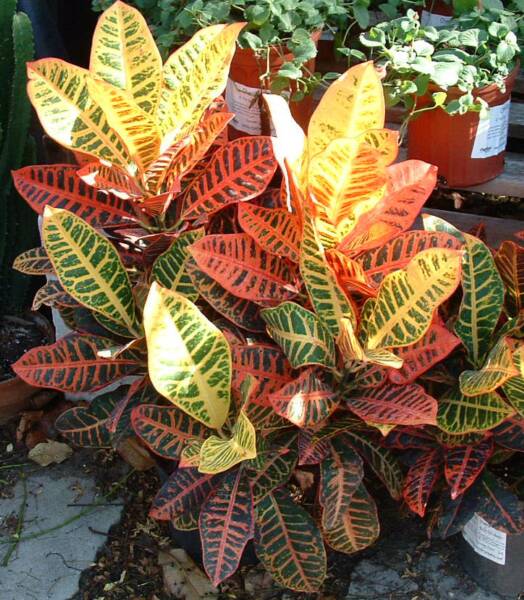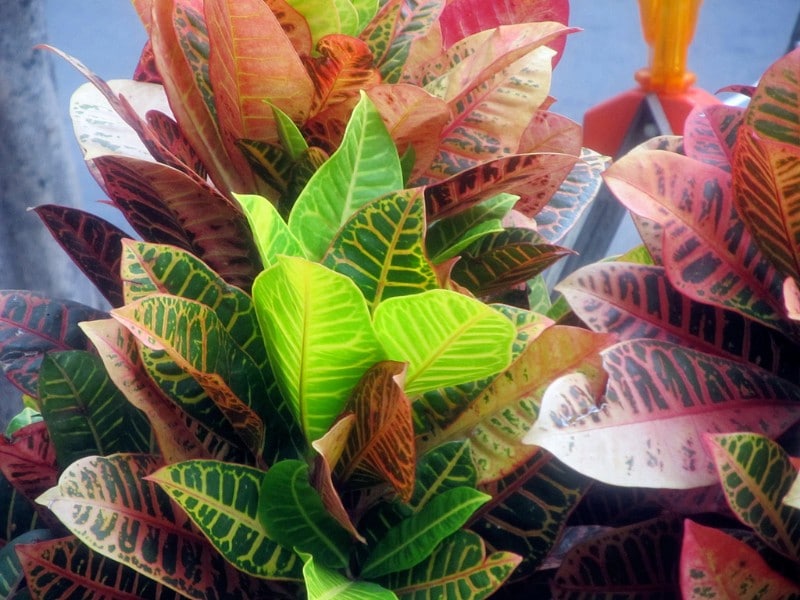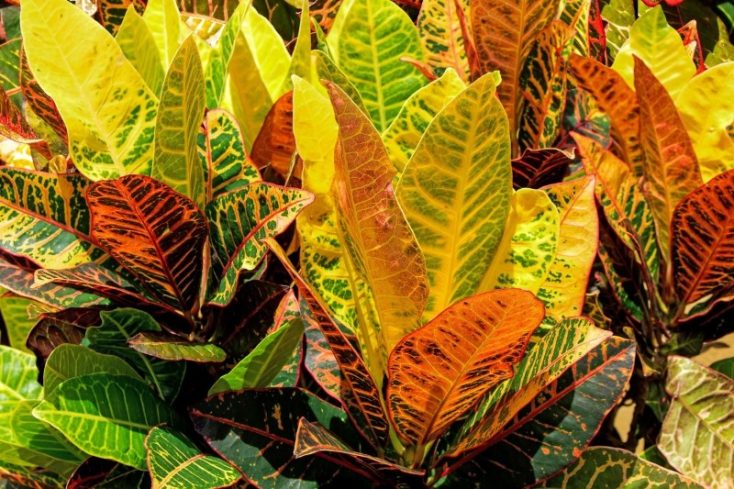The croton plant (Codiaeum variegatum) is a popular houseplant that is prized for its lush, dazzlingly colored foliage. It has a reputation for being difficult, as it is common to find your croton plant dropping leaves soon after bringing it home from the store. But don’t be discouraged if this happens with your plant, as a croton plant dropping leaves is normal behavior. I’m going to tell you why it happens, how to fix it and how to prevent it.
Why is my croton plant dropping leaves? When a croton plant drops leaves, it’s a reaction to stress, which can be caused by sudden changes as well as improper care. To avoid inducing stress, provide Codiaeum variegatumwith a stable moist tropical environment. It’s particularly important that you move croton plants as little as possible.
Following a brief introduction to the croton plant, this article will teach you what causes a croton plant to drop its leaves and what to do if your croton plant drops its leaves. I’ll also cover what the specific needs and care of a croton plant are and how to avoid causing stress to your plant in the first place. I’ve also got some handy tips, facts, and answers to questions about Codiaeum variegatum that will help you to enjoy this this vivacious houseplant for many years to come.

The Croton Plant Comes In A Glorious Array Of Leaf Shapes, Sizes, And Colors
The croton plant is a bushy broadleaf evergreen shrub that is native to open forest and scrub areas of tropical Southeast Asia, Indonesia and other islands of the Pacific Ocean, and Australia. It produces striking variegated foliage that is thick and smooth, with a leathery texture and an attractive, glossy sheen, and they come in an astounding variety of shapes, sizes, and bright, bold colors.
The croton plant’s leaves may be narrow or broad, oval or oak like, twisted, curled, or straight, while color tones range from yellows, oranges, and reds to pink, purple, white, bronze, and green.
The growth habit of Codiaeum variegatum shows prolific branching, producing a plant that is very full, due to the way the large leaves cluster together. These voluminous shrubs may grow to as high as 10 feet (3 meters) tall in the wild. But when grown as indoor houseplants, they reach a height of about 3 feet (90 cm) and a spread of around 2 feet (60 cm).
While mature croton plants may produce flowers, they are small and inconspicuous, outshined by gorgeous exotic foliage that will turn any indoor garden into a tropical paradise.
Confusion Over The Croton Plant Versus The Croton Genus
The croton plant being discussed here is a species of plant with the scientific name of Codiaeum variegatum. It belongs to the genus Codiaeum, which only contains a few species; however, there are several hundred cultivars of Codiaeum variegatum that feature a wide variety of leaf shapes, sizes, and colors.
Confusingly, the croton plant is related to but not the same as plants in the genus Croton, which contains over 1,200 species and is one of the largest genera of flowering plants. Both the Croton and the Codiaeum genera are members of the Euphorbiaceae (spurge) family of plants that are mostly native to tropical regions of Indomalaya and Australasia. Thus, referring to Codiaeum variegatum as the “croton plant” rather than simply “croton” helps to avoid this confusion.
Other common names for Codiaeum variegatum include:
- Garden croton
- Variegated croton
- Variegated laurel
- Joseph’s coat
Note that you may see the name “rushfoil” being included as one of the common names for Codiaeum variegatum, but this is mistaken. The term refers to plants in the Croton genus, and it may be used as a common name for the entire genus as well as for specific species belonging to this genus.
Help – My Brand New Croton Plant Is Dropping Its Leaves!
If you recently introduced a healthy new croton plant to your home, only to discover that it’s losing its leaves, don’t despair! You haven’t killed your plant. Simply give it proper croton plant care, and after a short period of readjustment, new leaves will appear. The plant should go on to grace your home with its vibrant foliage for years to come, as long as you continue providing it the right conditions and care.
If, however, you’ve had your plant for a while and it begins losing leaves, you will have to do a bit of detective work to identify the cause so you can remedy the situation.

What Causes Croton Plants To Drop Their Leaves?
The crux of the problem of croton plants dropping their leaves is that, while it is a resilient and robust houseplant, Codiaeum variegatum is very averse to change, and its reaction to the shock of sudden environmental changes is to drop its leaves. This behavior often causes a newly purchased croton plant to drop some or all of its leaves within days – which can come as quite a shock for a new croton plant owner who is unaware of this habit!
So, if your croton plant is dropping leaves, it could be caused by any kind of alteration in environmental conditions such as temperature, humidity, light, and location. Thus, the move from the nursery to your home or a mere relocation to a different spot in your home can stress your plant out.
The sudden changes that affect these plants can also come in the form of fluctuations in temperature that can occur if the plant is located near an exterior door or window, close to a heating or cooling vent, or in a drafty room. The temperature of the water you use when you irrigate your croton plant can also cause shock to the plant.
In addition to being sensitive to environmental changes and extremes, croton plants are also very particular about their growing conditions. Native to habitats that are warm, sunny, and moist, these plants will begin dropping leaves if they aren’t receiving the heat, light, and humidity they crave.
Beyond these peculiar sensitivities, Codiaeum variegatum is like other houseplants in being at risk of the damage and diseases that can result from improper care such as over-watering and allowing the soil to become soggy. Under-watering will also cause stress in many houseplants, including the croton plant, as will over- and under-fertilizing and allowing the plant roots to become pot bound.
How To Fix Problems That Are Causing Croton Leaf Drop: Proper Croton Plant Care
In a nutshell, the remedy for a croton plant that’s dropped its leaves is to provide the plant with the proper growing conditions and care. This section covers the care instructions you should follow to correct a problem that is causing your plant stress, so you can revive your Codiaeum variegatum and make sure it is getting everything it needs for robust stress-free growth moving forward.
Soil For Croton Plants
Choose a humus-rich potting mixture for your croton plant that will allow you to provide your plant with plenty of water but doesn’t remain soggy, as this will cause root rot, which will stress the plant and lead to leaf drop.
A soil-based mixture that includes peat-free compost works well for Codiaeum variegatum, while adding a medium such as grow rocks or pumice stones will improve drainage as well as aeration of the plant roots.
Choosing A Container For Your Croton Plant
As with the potting soil, the container for your croton plant should be one that prevents harmful sogginess in the root zone. So make sure the pot you choose has drainage holes in the bottom of it. You may also want to place some gravel in the bottom of the pot to help ensure that excess moisture can drain out every time you water your plant.
Use a pot that is about one-third larger than the size of your croton plant’s root ball, and repot the plant into a larger container every two years in the springtime to prevent its roots from becoming pot bound.
Light Requirements

Croton plants need 6-8 hours of bright sunlight and at least 2-3 hours of direct sunlight each day. But don’t overdo it with the direct sunlight, as excessively hot or harsh midday light can scorch the leaves, which results in gray patches on the leaves.
On the flip side, not only will insufficient sunlight stress the plant and cause it to drop leaves, but it will also cause croton foliage to lose its fiery color and fade to green. It’s the bright lighting that brings out the magnificent coloration of Codiaeum variegatumleaves. And generally speaking, the more variegated the foliage, the more light the plant needs.
Temperature
Provide your croton plant with consistent temperatures between 60 and 85 degrees Fahrenheit (16-30 °C). While this temperature range is typical of modern indoor environments and is therefore not difficult to achieve, the main concern with Codiaeum variegatum is consistency.
To avoid severe temperature fluctuations that will shock your plant, make sure it is not positioned near or exposed to any external doors or windows, heating or cooling vents, ventilation fans, or drafts.
Humidity
To mimic the tropical environment that Codiaeum variegatumoriginates from, generate a high level of humidity around your plant. It needs to be in the range of 40-80 percent, with 70 percent being optimal. To ensure that your croton plant is receiving the amount of moisture it needs and avoid stressing the plant, consider using a hygrometer so you can monitor the humidity carefully.
There are several ways you can generate the high local humidity that the croton plant craves:
- Humidifier: A humidifier is a great option if you want to improve the humidity level in your home generally, or if you have a lot of plants that have high humidity requirements. They are fairly inexpensive and are very reliable. Check out the reviews of this model on Amazon that would be ideal for increasing humidity for your houseplants.
- Humidity tray: Place pebbles in a shallow tray, fill it with water, set the potted plant on top of the pebbles, making sure the bottom of the pot is not sitting in the water, and then just make sure there’s always some water in the tray
- Misting:Mist the foliage every morning (allows time for the water to evaporate before nightfall to prevent fungal disease), being sure to use lukewarm water so as not to shock the plant
- Bathroom: Locate your croton plant in a bathroom where the use of the shower will create a moist environment that will make your plant feel right at home
Watering Croton Plants
Water your croton plant when the top half inch (13 mm) of soil feels dry during the spring, summer, and early autumn, cutting back and only watering when the dryness at the top of the soil reaches about an inch (25 mm) during the plant’s dormant period in the late fall and winter. The idea is to keep the potting soil moist but not soggy.
When you water, use lukewarm water to avoid shocking your plant’s roots. Water the potting soil thoroughly, irrigating until water begins to flow out of the pot’s drainage holes, making sure that you never leave the pot in standing water for more than about 15 minutes while you allow all the excess water to make its way out.
Fertilizing
Croton plants require plenty of nutrients to produce their lush,vivacious foliage. During the spring, summer, and early fall, feed Codiaeum variegatummonthly with a fertilizer that’s high in nitrogen and potassium, but hold off on fertilize during the plant’s dormant period.
Cleaning
To make sure the thick, leathery leaves of your croton plant are able to perform photosynthesis at their greatest potential, thus maximizing the energy production of the plant, periodically clean them with a damp cloth. This will not only help with plant health, but it also enhances the beauty of the leaves, allowing there colors to shine at their brightest.

Pests And Diseases
You generally don’t have to worry too much about diseases attacking your croton plant, beyond those that can develop if moisture in the soil or on the foliage is never allowed to dry out.
As for pests, watch out for common houseplant pests such as scale, spider mites, and mealybugs, which will cause stress and leaf drop if the infestation gets out of hand. To prevent such insect infestations, spray your croton plant down with a good blast of water from a garden hose once a week.
Preventing Croton Plant Shock And Stress From The Outset
The best way to deal with the sensitivities and intolerances that cause croton plants to drop their leaves is to do your best to prevent them from happening in the first place, and there are a couple of things you can do when introducing a new croton plant into your home that could make a big difference in the overall health of the plant.
First, consider what season of the year it is when you go to purchase a new croton plant. If you buy one in the wintertime, you will likely end up exposing it to cold when you transport it home. So it’s a good idea to wait until warmer weather to buy a new croton plant.
Upon bringing your new croton plant home,the most important decision you will then have to make is where to put it. Remember, you want to avoid moving Codiaeum variegatumas much as possible.
Consult the croton care section of this article and then determine what location will provide the best lighting, temperature, and humidity for your plant from the get-go. This way, you will be preventing the plant from becoming stressed by a lack of proper growing conditions as well as avoiding having to move it, which piles an additional shock on top of the stress a plant that was not thoughtfully positioned is already experiencing.
Why Are My Croton Plant Leaves Turning Brown At The Edges?
If your croton leaves are turning brown at the edges, it could be due to lack of the proper level of humidity, soil that is too dry, or exposure to temperatures that are too cold.
Are Croton Plants Poisonous To People Or Pets?
When injured, Codiaeum variegatum bleeds a white, milky sap containing an oil that has strong irritant and purgative properties. This sap is a skin irritant that can cause contact dermatitis while ingestion of the sap by both people and animals induces nausea and vomiting. Additionally, be very careful with the seeds of this plant, as they can be fatal to children if consumed.
If you have a croton plant or seeds in your home, make sure they are out of reach of children and pets – especially cats.
Also, care must be taken when handling the croton plant. Always wear gloves and avoid contact with your eyes. If the sap does happen to come into contact with your skin, wash the area well with soapy water.
Do Croton Plants Need Pruning?
No, croton plants generally don’t require pruning to grow healthy and strong. As long as you give your plant plenty of space to accommodate its bushy growth, the only pruning you may need to do is to remove any dead leaves or branches. It’s best to prune croton plants in early spring, just before the growth season begins. Don’t forget to wear gloves!
Preventing problems with your houseplants comes with a combination or knowledge, experience and the right tools and equipment. Check out my recommended resources page to see what books, resources and tools I recommend for looking after your houseplants. Happy growing.

